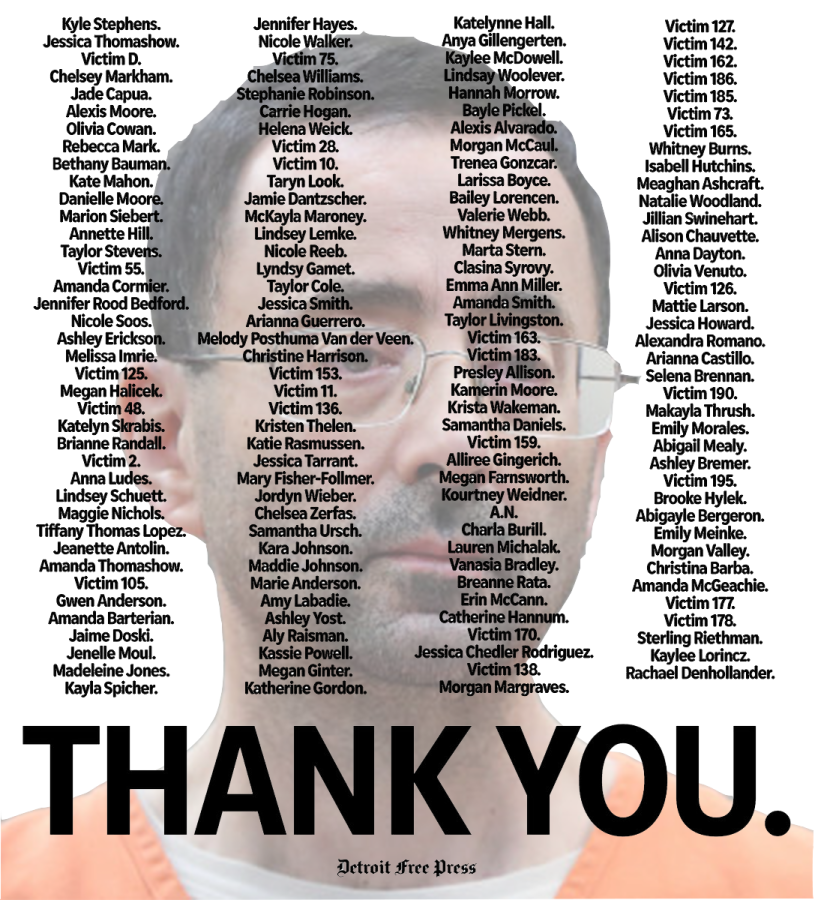The aftermath of Larry Nassar’s sentencing
February 17, 2018
As each woman stepped up to the witness platform and addressed the established, kind doctor they had once trusted, their words traveled beyond the walls of Michigan’s Ingham County Courthouse, deeply felt by all who had watched the case unfold. Larry Nassar’s world began to crumble around him.
On Jan. 24, Nassar, former national doctor of the USA Gymnastics team and a sports physician at Michigan State University, was sentenced to 40 to 175 years in prison after pleading guilty to the sexual assault of minors, particularly young female athletes who came to him for treatment. Before pleading guilty to sexual assault, Nassar had been sentenced to 60 years in prison on child pornography charges; with his new sentence, Nassar will spend the rest of his life in prison. Nassar’s case started from November of last year, when he pleaded guilty to sexually molesting seven girls; however, as eventually more than 200 victims, including Olympic gold medalists Simone Biles, Aly Raisman and McKayla Maroney, stepped forward during court hearings, the case began to gain the attention of Americans nationwide, uncovering the uglier side of gymnastics culture. Shortly after Nassar’s sentencing, Michigan State University’s president and athletic director resigned, as did all 21 members of the USA Gymnastics Board of Directors.
Nassar’s fall from renowned physician for the national gymnastics team to a sexual predator facing a life in prison attracted the attention of the public unlike any other. Furthermore, the courage of the young athletes who spoke out against their abuser marked a powerful pinnacle of the modern feminist movement. Judge Rosemarie Aquilina, who headed the hearings, further drew respect and praise from the public, as she encouraged victims to face their now powerless abuser with their words. Indeed, Aquilina’s tossing aside of Nassar’s written letter of plea to the court was hailed as one of the highlights of the case. By giving each victim a chance to speak out, she granted a sense of freedom to each young woman and her family, encouraging them to “go out and do your magnificent things.” Aquilina’s dignified presence throughout the hearings and the hard-hitting statements of the young women who spoke out against Nassar defined the power of women.
I was certainly moved by the compelling victim statements, but beyond their powerful words, I was shocked by the sheer number of victims, including several Olympic gold medalists, who accused Nassar, a single man, of sexual assault. The number of times these young athletes had been inappropriately treated, yet were unable to find a sympathetic ear afterward, clearly showcased the blatant failure of USA Gymnastics and Michigan State to address such issues before Nassar’s actions became so far-reaching. Each victim who stepped forward represented yet another time Nassar was able to get away with his appalling actions, under the guise of a caring doctor and established member of USA Gymnastics. The root of issue does not lie only within Nassar’s case, but concerns the negligence of USA Gymnastics and America’s athletic culture. Indeed, upon further investigation into USA Gymnastics, authorities discovered that there have been more than 360 cases of sexual misconduct reported by gymnasts over the last 20 years. USA Gymnastics has since banned 37 of the 54 coaches found in their files, but this delayed response clearly demonstrated their failure to take action in previous cases. Besides Nassar, there are likely other seemingly trustworthy adults in positions of power, and many young athletes being subjected to sexual abuse behind the bright lights and applause of a packed stadium.
One prominent point I heard repeated throughout the victim statements was a lack of trust and credibility when the young athletes reported uncomfortable experiences during their doctor visits. Michigan State University, where many of Nassar’s sexual advances took place, failed to address concerns of their students, while USA Gymnastics went as far as to force athletes, such as Olympic gold medalist McKayla Maroney, to enter a confidential settlement in order to cover up her claims of sexual assault by Nassar. For most of the girls, they had no idea that what Nassar was doing was wrong, and were influenced by athletic culture to trust their doctors. They were forced to endure countless “procedures” along their gymnastics journey. As the national team doctor, Nassar wielded a large amount of power and ethos over athletes in their early teenage years of training. Coupled with his kind demeanor and the young athletes’ naiveté, Nassar had virtually unrestricted freedom to force his sexual advances on his patients.
Melissa Imrie, who was assaulted by Nassar when she was 12, suffered severe depression and insomnia in the years that followed. Maddie Johnson described feeling sick whenever she heard the word, “kiddo” said in the same way Nassar did before sexually abusing her. Lavonda Simon, the mother of Megan Simon, told the court her daughter committed suicide in 2012 when she was 23 after being inappropriately touched by Nassar multiple times while her parents were in the room. The stories of these victims moved me; no young athletes in their teens, the age range of most of Nassar’s victims, should be subject to assault that leaves scars for years, perhaps for the rest of their lives.
Nassar’s case should serve as a constant reminder to America’s athletic organizations, as well as any other industries, to listen to any concerns so that such inappropriate action can be identified and eradicated quickly. As six-time Olympic gold medalist Aly Raisman bravely noted, “If over these many years, if just one adult listened and had the courage and character to act, this tragedy could have been avoided.”



































































